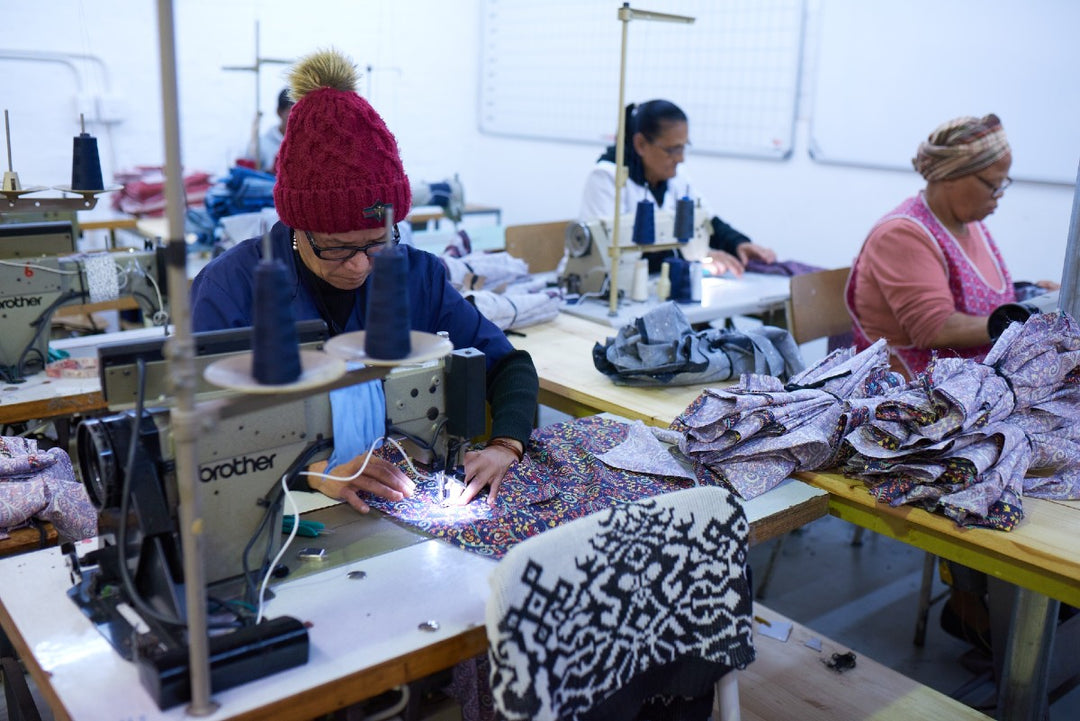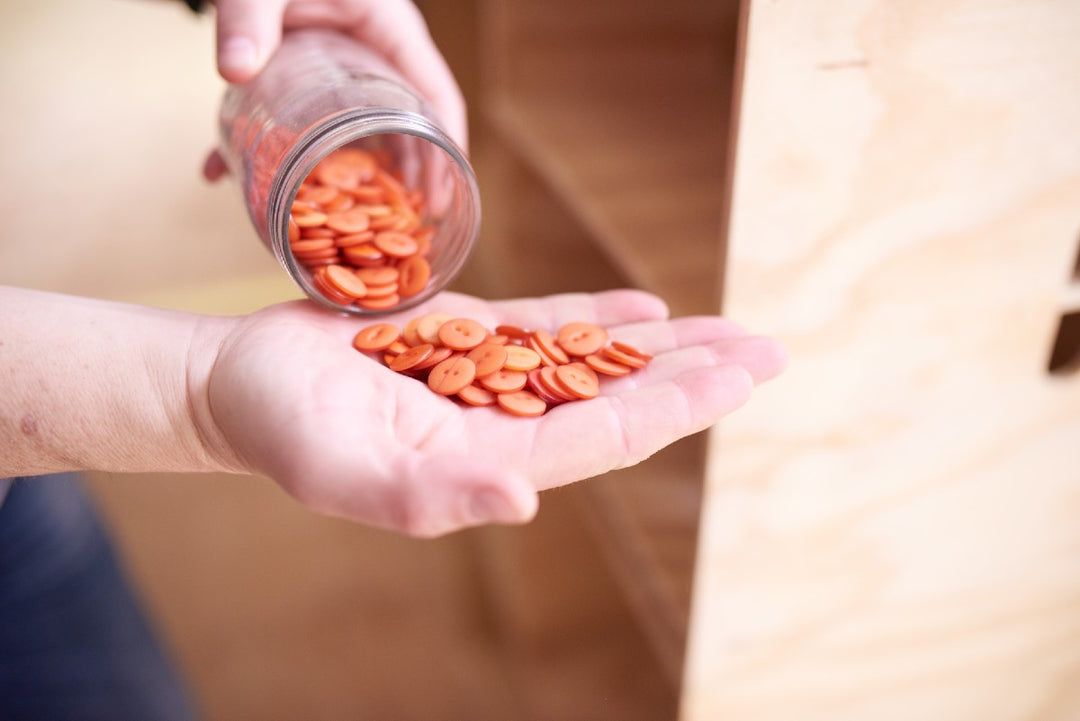What is poplin fabric?
Poplin is one of the most versatile and misunderstood fabrics in modern clothing. From crisp summer shirts to premium pajamas, cotton poplin offers structure, breathability, and lightness that synthetics can’t match. But what exactly is poplin, how is it made, and how does it compare to other materials?
What Is Poplin Fabric?
A Definition Rooted in Weave, Not Fiber
Poplin is a tightly woven fabric characterized by its fine horizontal ribbing, created through a plain-weave structure that uses a higher thread density in the warp (vertical) and a slightly thicker thread in the weft (horizontal). The result is a fabric with a smooth surface, excellent drape, and a balance of lightweight softness and durability. While many people associate poplin with cotton, the term technically refers to the weave, not the fiber — meaning poplin can also be made from silk, wool, polyester, or blended materials. At Woodstock Laundry, we exclusively use 100% GOTS-certified organic cotton for a clean, breathable, and fully natural experience.
Surface, Weight, and Structure
What sets poplin apart from other weaves is its crisp hand-feel without bulk. It doesn’t have the visible texture of oxford or the stretch of jersey, but it has its own distinctive structure — flat, slightly lustrous, and stable. In garments, this translates to a polished look that doesn’t feel rigid. It’s thin enough for summer but substantial enough to avoid being sheer. This unique quality makes poplin ideal for garments that need to look sharp while still offering breathability, such as shirting, sleepwear, or tailored loungewear.
The Origins of Poplin: From Papal Robes to Modern Shirts
The term “poplin” has its roots in 15th-century France, where the fabric was known as “papelino,” a name derived from the papal city of Avignon. Poplin was originally woven from silk and wool, and it was favored for ceremonial and formal attire because of its rich appearance and elegant drape. The material's adoption in the Vatican and surrounding regions gave it a status associated with authority and refinement. By the 18th and 19th centuries, cotton had largely replaced silk and wool in popular versions of poplin, making it more accessible while maintaining its signature qualities.
Poplin in Contemporary Fashion
Today, poplin has become a staple in everyday wardrobes across both menswear and womenswear. It’s frequently used for dress shirts, pajamas, boxer shorts, and summer dresses — especially in brands that prioritize natural fibers and high-quality tailoring. While some mass-market brands use synthetic blends to lower costs, premium labels (like ours) continue to focus on 100% cotton poplin for its breathability, eco-friendliness, and superior comfort. Its clean surface also allows for vibrant prints, which is one reason why we use poplin as the foundation for many of our most expressive collections.
How Is Poplin Made?
A Closer Look at the Weave
Poplin is made using a plain weave — the simplest and most commonly used weaving technique in textile manufacturing. In a plain weave, the horizontal weft yarn passes alternately over and under each vertical warp yarn, creating a balanced crisscross structure. What differentiates poplin from other plain weaves is the use of finer yarns in the warp direction and slightly thicker yarns in the weft. This subtle contrast produces the very fine ribbing effect characteristic of poplin, while still preserving a smooth and flat surface.
Despite its minimal appearance, the structure of poplin is what gives it strength and resilience. The tight spacing between threads means fewer gaps, which not only prevents sagging and stretching but also improves the fabric’s ability to hold its shape. This tight weave is also what gives poplin its mild sheen and ability to resist surface pilling, making it ideal for repeated wear and wash.
The Role of Fiber Quality
Poplin’s performance isn’t just about the weave — it’s also about the yarns used. At Woodstock Laundry, we exclusively use fine, long-staple organic cotton yarns. Longer staple length means each individual fiber is stronger, smoother, and less prone to breakage. This improves the fabric’s resistance to fraying and gives it a clean, polished surface with minimal fuzz.
Organic cotton fibers also absorb dye more consistently than blended or synthetic alternatives. That’s one of the reasons our printed poplin fabrics retain their rich color saturation even after frequent laundering. The result is a fabric that doesn’t just look better — it performs better.
No Blends, No Shortcuts
Unlike many commercial brands that mix polyester or elastane into their poplin to reduce wrinkling or cut costs, we use only 100% GOTS-certified organic cotton. No plastic, no synthetics, and no compromise on breathability. This approach keeps the fabric breathable, naturally hypoallergenic, and fully biodegradable.
Finally, each batch of fabric is pre-washed after weaving, which helps stabilize the cotton, prevent unexpected shrinkage, and slightly soften the fabric without losing its signature crisp feel. It’s this combination of technical precision and fiber integrity that defines how our poplin is made — and why it feels so different when worn.
What Does Poplin Feel Like?
Poplin feels smooth, dry, and slightly crisp — not soft like jersey, but not stiff like canvas. It doesn’t stretch, but it moves well with the body and drapes neatly. On first wear, poplin can feel structured, but it softens with washing while retaining its crisp character.
This tactile sharpness makes poplin ideal for shirts, boxer shorts, and nightwear. It sits clean against the skin, doesn’t cling, and keeps its shape better than looser weaves.
Cotton Poplin vs Poly Poplin
Cotton poplin is breathable, biodegradable, and softens naturally over time. It absorbs dyes well and offers a matte or slightly lustrous finish. It’s also non-stretch and hypoallergenic.
Poly poplin (or cotton-poly blends) are cheaper and less breathable. They often feel slick or shiny and may trap heat. While they resist wrinkling better, they lack the tactile refinement and comfort of natural cotton.
All Woodstock Laundry products use 100% GOTS-certified cotton poplin.
What Is Poplin Fabric Used For?
- Button-up shirts and blouses
- Summer dresses
- pajamas and sleepwear
- Boxer shorts and underwear
- Lightweight jackets
- Uniforms and workwear (historically)
In our collections, poplin is the core material for men’s shirts, lounge shorts, women’s pajamas, and boxer briefs. Its breathability and smooth finish make it perfect for daily wear and warm climates.
Poplin vs Other Fabrics
Poplin vs Oxford
Oxford fabric has a basket weave and feels coarser. It’s thicker and more casual than poplin, making it better for colder seasons or more rugged styles.
Poplin vs Chambray
Chambray is plain-woven like poplin but uses a dyed warp and white weft, creating a more textured look. It’s often softer and less crisp than poplin.
Poplin vs Twill
Twill has diagonal ribs and is thicker, heavier, and less breathable than poplin. Twill is often used in chinos and denim, while poplin excels in summer wear.
Poplin vs Jersey
Jersey is knitted, soft, and stretchy. It’s better for T-shirts and casual loungewear. Poplin is woven, structured, and holds shape — ideal for refined comfort.
Poplin vs Denim
Denim is thick and twill-woven, made for durability. Poplin is light and breathable — not made to last forever but built for daily comfort and elegance.
FAQ: Cotton Poplin
What does poplin mean?
Poplin refers to a tightly woven plain-weave fabric, originally called papelino, used since the 15th century in Avignon, France.
What material is poplin?
Poplin is most often made from cotton, but can also be blended with polyester. We use only 100% organic cotton poplin.
Is poplin cotton?
Yes — when labeled as “cotton poplin,” it’s made entirely from cotton using a plain weave. Polyester versions also exist.
What is a poplin shirt?
A shirt made from cotton poplin, known for its clean lines, breathable structure, and crisp feel. Ideal for hot weather and layering.
Does poplin wrinkle?
It can crease lightly, but less than looser weaves. A light steam or iron smooths it easily. It won’t look sloppy like linen.
Is poplin good for summer?
Yes — it’s one of the best fabrics for summer due to its lightness, breathability, and dry feel. It doesn’t trap heat or moisture.
Is poplin stretchy?
No — poplin has no stretch. It’s woven for structure. Some fast-fashion brands add elastane blends, but that’s not true poplin.
What does cotton poplin feel like?
It feels crisp, cool, and smooth — like a high-end shirt or tightly woven pajama. Not plush, but always breathable and refined.
Does poplin shrink?
If not pre-washed, it may shrink slightly. We pre-wash all our cotton poplin. Always wash in cool water and line dry when possible.





